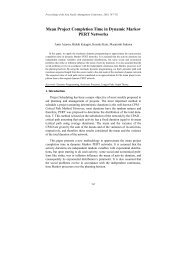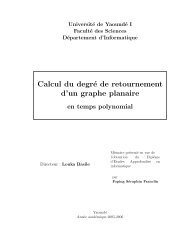Models for Global Constraint Applications - Cork Constraint ...
Models for Global Constraint Applications - Cork Constraint ...
Models for Global Constraint Applications - Cork Constraint ...
You also want an ePaper? Increase the reach of your titles
YUMPU automatically turns print PDFs into web optimized ePapers that Google loves.
• The second case study (section 3) is the MOSES feed mill scheduling<br />
system [55, 4], a complex, multi-resource production scheduling system<br />
with an interactive problem solver.<br />
• The third study (section 4) is an instance of a nurse rostering system called<br />
GYMNASTE [74, 21, 22, 20] developed in France and in practical use in<br />
hospitals there. It is one instance of personnel planning and assignment<br />
systems, which have been very successfully implemented using constraint<br />
programming.<br />
For each case study, we present the problem in general terms, then discuss<br />
the model by describing variables and constraints, mention possible additional<br />
constraints and look at possible search routines <strong>for</strong> this problem type.<br />
In section 5 at the end of the paper we try to extract common characteristics<br />
of the problems, which should be similar <strong>for</strong> many other constraint applications<br />
as well.<br />
2 APACHE - Airport Stand Allocation<br />
This <strong>for</strong>m of assignment problem arises in many transportation systems. We<br />
present here the model <strong>for</strong> airport stand allocation, but similar problems are<br />
also common in train operations (dynamic plat<strong>for</strong>m allocation <strong>for</strong> train stations)<br />
and <strong>for</strong> harbour operations (berth allocation).<br />
2.1 Problem<br />
The description of the problem is based on [25], the model presented here has<br />
been first discussed in [54]. For flights arriving at and departing from an airport,<br />
we have to allocate parking positions, which are needed from the time of arrival<br />
to the time of departure. Many of the parking positions (also called stands)<br />
are located at a terminal, with a walkway connecting the plane parked in this<br />
location to a gate in the terminal. There are often other parking positions off<br />
the terminal (on the apron), where planes can be parked <strong>for</strong> longer periods, but<br />
where passengers must be transported by mobile lounges or buses, causing cost,<br />
inconvenience and often delay. At most airports, the set of possible stands is<br />
a predetermined, finite set, making this problem an ideal candidate <strong>for</strong> finite<br />
domain constraint programming.<br />
Not every plane can be parked at every location: There are physical constraints<br />
due to plane size and type, or the walkway may be incompatible with<br />
the particular aircraft type. Often, certain parts of the terminal are reserved<br />
<strong>for</strong> specific airlines, and usually national and international flights must be kept<br />
separate due to customs regulations. There are also typical security restrictions,<br />
where flights from/to certain countries must be handled via more secure<br />
areas of the airport. Given in<strong>for</strong>mation about the aircraft, its type and flight<br />
numbers of arriving and departing flights it is easy to come up with the set of<br />
possible stands that can be used <strong>for</strong> one particular airplane. We often also have<br />
preferences <strong>for</strong> particular stands.<br />
The main objective is to come up with a feasible solution, one which satisfies<br />
all hard constraints. We then try to find a solution which reduces operational<br />
4









